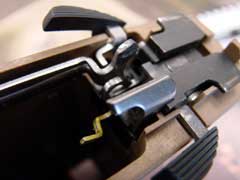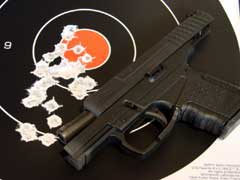|
About a week ago, I got on a plane in Nashville
and headed for Massachusetts for a visit with the folks at Smith
& Wesson. I had visited there briefly about two years
ago, but this was to be a more in depth tour of the factory and
other facilities, such as their very modern indoor shooting
range.
Arriving at the airport in Hartford,
Connecticut, I was introduced to two other writers who were
guests of S&W for the week; Frank James and Leroy
Thompson. I knew both of these gentlemen on sight, for I
have read their work for many years. Both write for reputable
magazines, and Mr. Thompson also has a book out that contains a
lot of useful information on VIP Protection and such. Mr. James
has written books on the defensive use of a handgun, and on the
MP5 Submachine gun, and probably a few others. Look for
Gunblast reviews of some of those books shortly.
The first evening, we were treated to a private
tour of the old Springfield Armory Museum, which is now
under the administration of the National Park Service, and what
a delight that tour was! I saw rack after rack of antique
firearms dating from the American revolution, and progressing
forward through the Vietnam era weapons. It was a history of our
nation through firearms. It is amazing to me how the early
Americans were able to manufacture that vast amount of arms
without the benefit of electrical power. Even later during the
two major world wars, Americans turned out a staggering amount
of arms and ammunition to supply the free world. If you are ever
near Springfield, Massachusetts, I highly recommend a visit to
the old Armory Museum. After that, we were off to a fine
supper somewhere downtown. Seems like a bit of everything
was on the menu, but I settled on a huge piece of pork loin
stuffed with ham and cheese. You just canít hardly beat pork
stuffed with pork! Mighty fine eating.
After a good nightís sleep, we were off to the
Smith & Wesson offices to have a look at some new products
that are being introduced by S&W. Messrs. James, Thomson,
and I were joined by another writer, but I canít remember his
name at this time. Nice fellow though. In recent years, Smith
& Wesson has been really aggressive in pursuing segments of
the gun market in which they were not involved before, such as
their 1911 auto pistol and the M&P
AR-15 rifle. In both product lines, S&W didnít just
stick their toe in the water to test the market. They jumped in
with both feet, and it has paid off well. If you look at their
quarterly profits, or have tracked S&W in the stock market
over the last year, you know that they are definitely doing
something right. I really like their 1911 pistol, and have
reviewed a couple of them. I have also fired a couple of their
M&P AR rifles, and find them to be superior to most of their
competitors.
One of the newest product lines for Smith &
Wesson is their move into the bolt action hunting rifle market.
The I-Bolt has some interesting features that set it
apart from the competition. S&W did not set out to copy a Mauser
or Remington or some other rifle action. Instead, the
I-Bolt is a strong, light, and rigid action set into a unique
stock design that is also light weight but stiff to fully
support the action. It has a place in the stock for an optional
lead/oil recoil reducer, an adjustable Timney trigger,
sixty degree bolt lift, and comes with a one-piece bridge scope
base attached. The first year will be long action
cartridges only, such as the .30-06, .270, and .25-06. Good
choices. Next year, we should see a short action .308 with a
detachable box magazine and a heavy barrel.
In the handgun line, I got to handle the new .45
M&P auto pistol again. I have been and continue to be
impressed with the M&P pistols from Smith & Wesson. They
are world-class, and the .45 ACP version is a real dandy. It can
be had with or without a thumb safety. Also shown to us were the
M&P revolvers, and the anxiously awaited return of
the beloved Model 63 J-frame .22
Long Rifle stainless Kit Gun. These new ones will
feature an eight-shot cylinder and five inch barrel at first.
Smith & Wesson is the North American
distributor for Walther pistols, and the new PPS is a
very slim and light pocket auto chambered for the 9mm Luger
cartridge. The first ones will come with three magazines; a six,
seven, and eight shot. It has good highly visible sights, a
plastic frame, and a good trigger pull.
Also shown to us was the new line of high
quality double barrel shotguns that I got to shoot briefly at SHOT
earlier this year, along with their new gas-operated semi-auto
shotgun. The doubles are very good-looking classy field guns
retailing for just over $2000, and the semi-auto will be a very
competitive field gun for hunters.
After a morning of fondling the new guns, we
were fed a big lunch, and then headed down into the factory for
a close-up look at the making of the Smith & Wesson
firearms. I was very impressed by the use of the most modern CNC
machines available, along with the use of the old behemoth
hammer forge that has been around for decades. In the forge,
workers take a red-hot piece of steel, and the big machine slams
it into the shape of a revolver frame, pistol slide, or other
such part. Also present were parts that were obviously not
handgun or AR-15 parts at all. Smith & Wesson forges parts
for other companies also, some within the gun industry, and
others in the automotive and other industrial sectors of
manufacturing. Same thing with Smithís heat treating facility.
They contract heat-treating for others within and without the
gun industry. The CNC milling machines were very
impressive. S&W has invested over eighty million dollars in
new machinery in the past five years, and it is paying off in
terms of both quality and speed of production. What used to take
127 different operations to complete a revolver cylinder now
takes only sixteen minutes and one machine. An operator loads a
length of steel into one end of the machine, and finished
cylinders come out the other end ready for final polishing,
which is also done by a robotic machine. Revolver side plates
that were once tediously fitted by hand are now made exactly the
same by a machine that is constantly measuring and adjusting for
tolerance. The result is revolvers with parts fitted much better
than they were just a few years ago, and cost increases held to
a minimum. Another way in which S&W holds down costs and
pumps up quality is that they have their own tool-making shop,
producing the cutters and end mills for their CNC machinery
in-house. While S&W handguns have never been cheap to
purchase, in todayís dollars, they are more affordable than
ever before. All this is made possible by constantly upgrading
their equipment for tighter tolerances and faster production.
Tighter tolerances mean less time fitting, and a better quality
product. While some in the gun industry, Winchester (USRAC)
being a recent example, refuse to modernize and cannot compete
and stay in business, S&W is at the top of their game. I am
also a bit worried about a couple of others in the gun business
that operate on old machinery and with antiquated union rules
that prevent the company from making a product that shooters
will buy. The Winchester lever and bolt rifles that were built
in New Haven, because of stupid union contracts, will likely
never be built again in the US, at least for a few years anyway.
With such archaic agreements with the union, Winchester loses,
the workers lose, and shooters lose. Nobody wins. S&W
isnít afraid to modernize, and that allows them to compete
with the best firearm designs in the world. They sell their
M&P pistols, for example, competitively with those brought
in from Eastern Europe and South America, and provide a product
that is second to none.
Anyway, after a long day at the factory, we were
again fed like royalty and sent to bed tired and full. The next
day was a day at the S&W shooting range. We got to
shoot several revolvers and auto pistols. Especially popular
with Messrs. James, Thompson, and myself were the M&P .45
auto pistols and the Walther PPS. I was impressed by the
accuracy and shooting qualities of both of these pistols. I also
really liked shooting the lightweight 386 ScS seven-shot
.357 magnum revolver. It was very accurate as well as a
fun-to-shoot handgun. Shooting offhand at seven yards, 35
shots clustered most shots into about two inches, then I started
to pull the shots out of the group, so I stopped shooting that
lightweight .357 magnum. Recoil is a cumulative thing, and the
effects were starting to show in my shooting ability. Same
thing with the 9mm PPS. It also turned in a very respectable
showing on target, grouping 24 shots a bit low and left for me,
but tight enough for social work nonetheless. I really like the
PPS, and requested a test gun for a full review as soon as
possible.
It had been a couple of years since I was last
at the Smith & Wesson factory, and I came away very
impressed by the facility, the tooling, and the people. They
told me that the average tenure of workers at the factory is
twenty-seven years. Equally important, many of the top managers
started years ago on the production floor, and have a vast
knowledge of what it takes to make a quality handgun. They are
also shooters and hunters. Everyone that I met, from the
President on down, seemed genuinely interested in providing
products that shooters want, and they listened to the opinions
of their guests on those three days at the factory. Smith
& Wesson is a company that combines the old with the new,
making classic revolvers and world class auto pistols, along
with rifles and now a line of quality shotguns that are being
built by S&W in Turkey. The Performance Center turns
out some very high quality production runs of special handguns
for shooters who demand the very best. Smith & Wesson
handguns and rifles are built in America with American labor and
materials. That means a lot to me. There are some fine weapons
made elsewhere in the world, but it pleases me to see American
workers once again making weapons that are second to none in
quality, design, and workmanship. In that respect, Smith &
Wesson delivers. Look for full reviews on their new products
very soon. Check out the full line of S&W products at:
www.smith-wesson.com.
It was a good three days in Springfield,
Massachusetts. I want to thank the management and workers at
Smith & Wesson, and the good folks at Blue Heron
Communications for putting it all together. I had a
good time, and made some new friends. I also want to thank
Frank and Leroy for sharing their knowledge, experience, and
expertise in the brief time that we spent together, touring,
eating, and shooting both the weapons and the bull in
Massachusetts.
I also want to take this opportunity to welcome
Smith & Wesson as our newest advertiser. While that wasn't a
goal of this trip, the subject came up one night at supper, and
I am glad to welcome them to Gunblast.com. We have reviewed
their products for many years, and they build guns that I can
recommend to other shooters, as I often buy them myself, and I
carry one daily in my pocket.
Jeff Quinn
  
Got something to say about this article? Want to agree (or
disagree) with it? Click the following link to go to the GUNBlast Feedback Page.
|
|
Click pictures for a larger version.

A view of the safety lever on an M&P .45.

.44 Magnum "Survival Kit".


The Walther PPS.

S&W engraver at work.

John Ross Limited Edition Performance Center revolvers.

Performance Center Model 60 .357 3-inch "kit
gun".

Performance Center .460 XVR.

Engraved nickel-plated Model 29 .44 Magnum.


Parts awaiting assembly in the Performance Center.




M&P .45 slides go through the forging operation.

S&W helps control quality and costs by making their
own cutting tools.



S&W successfully combines old-world craftsmanship
with state-of-the-art CNC machinery.



Polishing operations.


M&P AR-15 rifles.


Revolvers are assembled by hand.

Frank James shoots the M&P .45.


Leroy Thompson (top) and the author (bottom) shooting
the Walther PPS 9mm.

M&P .45, 16 shots at seven yards offhand.

Walther PPS 9mm, 24 shots offhand at seven yards.

S&W 386ScS revolver, 35 shots offhand at seven
yards.
|
![]()